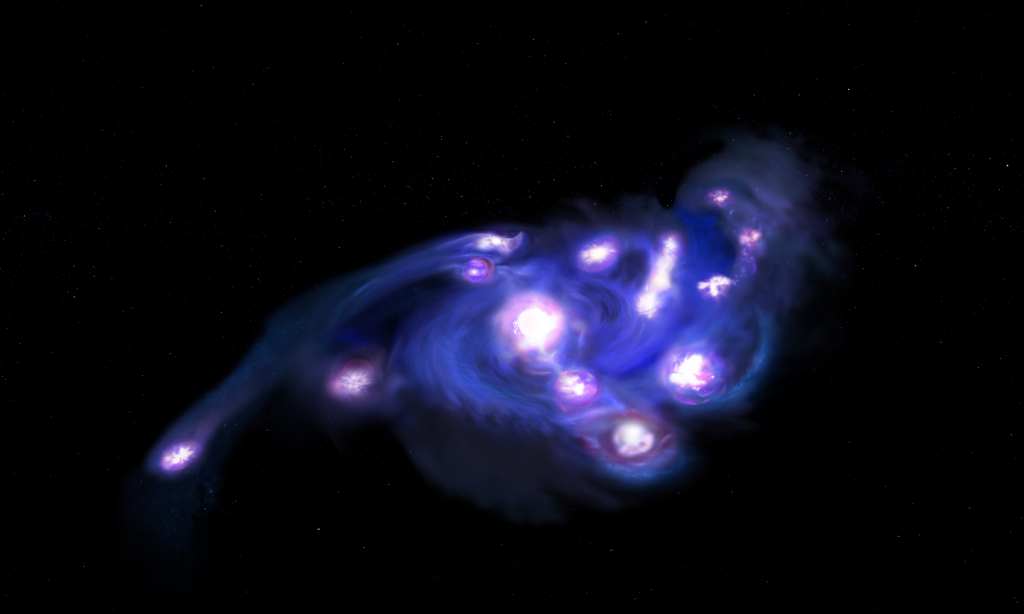The U.S. National Science Foundation National Radio Astronomy Observatory (NSF NRAO), in partnership with several leading Mexican universities and research institutes, has announced a series of landmark agreements and meetings aimed at advancing Mexico’s role in the Next Generation Very Large Array (ngVLA) project.
Recent News
Astronomers Discover a Superheated Star Factory in the Early Universe
Astronomers have uncovered a previously unknown, extreme kind of star factory by taking the temperature of a distant galaxy using the ALMA telescope. The galaxy is glowing intensely in superheated cosmic dust while forming stars 180 times faster than our own Milky Way.
Astronomers Share Largest Molecular Survey To-date: GOTHAM Legacy Data Goes Public
Astronomers in the “GBT Observations of TMC-1: Hunting Aromatic Molecules” research survey, known as GOTHAM, have released a spectral line survey with largest amount of telescope time ever conducted, charting more than 100 molecular species only found in deep space.
The Universe’s Secret Harvest: ALMA Sheds Light on ‘the Cosmic Grapes’

ALMA and JWST observations unveil unexpected details of rapid growth in a faint, newborn “grape-like” galaxy, similar to galaxies in the early universe following the Big Bang
Astronomers have discovered a remarkably clumpy rotating galaxy that existed just 900 million years after the Big Bang, shedding new light on how galaxies grew and evolved in the early universe. Nicknamed the “Cosmic Grapes,” the galaxy appears to be composed of at least 15 massive star-forming clumps—far more than current theoretical models predict could exist within a single rotating disk at this early time.
The discovery was made possible by an extraordinary combination of observations from the Atacama Large Millimeter/submillimeter Array (ALMA) and the James Webb Space Telescope (JWST), all focused on a single galaxy that happened to be perfectly magnified by a foreground galaxy cluster through gravitational lensing. In total, more than 100 hours of telescope time were dedicated to this single system, making it one of the most intensively studied galaxies from the early universe.
Although the galaxy had appeared as a smooth, single disk-like object in previous Hubble images, the powerful resolution of ALMA and JWST, enhanced by gravitational lensing, revealed a dramatically different picture: a rotating galaxy teeming with massive clumps, resembling a cluster of grapes. The finding marks the first time astronomers have linked small-scale internal structures and large-scale rotation in a typical galaxy at cosmic dawn, reaching spatial resolutions down to just 10 parsecs (about 30 light-years).
This galaxy does not represent a rare or extreme system. It lies squarely on the “main sequence” of galaxies in terms of its star forming activity, mass, size, chemical composition—meaning it is likely representative of a broader population. If so, many other seemingly smooth galaxies seen by current facilities may actually be made up of similar unseen substructures, hidden by the limits of current resolution.
Because existing simulations fail to reproduce such a large number of clumps in rotating galaxies at early times, this discovery raises key questions about how galaxies form and evolve. It suggests that our understanding of feedback processes and structure formation in young galaxies may need significant revision. The Cosmic Grapes now offer a unique window into the birth and growth of galaxies — and may be just the first of many. Future observations will be key to revealing whether such clumpy structures were common in the universe’s youth.
About NRAO
The National Radio Astronomy Observatory (NRAO) is a facility of the U.S. National Science Foundation, operated under cooperative agreement by Associated Universities, Inc.
About ALMA
The Atacama Large Millimeter/submillimeter Array (ALMA), an international astronomy facility, is a partnership of the European Southern Observatory (ESO), the U.S. National Science Foundation (NSF) and the National Institutes of Natural Sciences (NINS) of Japan in cooperation with the Republic of Chile. ALMA is funded by ESO on behalf of its Member States, by NSF in cooperation with the National Research Council of Canada (NRC) and the National Science and Technology Council (NSTC) in Taiwan and by NINS in cooperation with the Academia Sinica (AS) in Taiwan and the Korea Astronomy and Space Science Institute (KASI).
ALMA construction and operations are led by ESO on behalf of its Member States; by the National Radio Astronomy Observatory (NRAO), managed by Associated Universities, Inc. (AUI), on behalf of North America; and by the National Astronomical Observatory of Japan (NAOJ) on behalf of East Asia. The Joint ALMA Observatory (JAO) provides the unified leadership and management of the construction, commissioning and operation of ALMA.
This news article was originally published on the NRAO website on August 7, 2025.
Recent News
NSF National Radio Astronomy Observatory and Mexican Institutions Sign Historic Agreements to Advance ngVLA Collaboration
The U.S. National Science Foundation National Radio Astronomy Observatory (NSF NRAO), in partnership with several leading Mexican universities and research institutes, has announced a series of landmark agreements and meetings aimed at advancing Mexico’s role in the Next Generation Very Large Array (ngVLA) project.
Astronomers Discover a Superheated Star Factory in the Early Universe
Astronomers have uncovered a previously unknown, extreme kind of star factory by taking the temperature of a distant galaxy using the ALMA telescope. The galaxy is glowing intensely in superheated cosmic dust while forming stars 180 times faster than our own Milky Way.
Astronomers Share Largest Molecular Survey To-date: GOTHAM Legacy Data Goes Public
Astronomers in the “GBT Observations of TMC-1: Hunting Aromatic Molecules” research survey, known as GOTHAM, have released a spectral line survey with largest amount of telescope time ever conducted, charting more than 100 molecular species only found in deep space.
